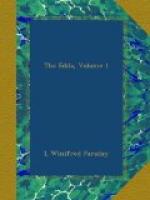Roughly speaking, the first two-fifths of the Ms. is mythological, the rest heroic. I propose to observe this distinction, and to deal in this study with the stories of the Gods. In this connexion, Snorri’s Edda and the mythical Ynglinga Saga may also be considered, but as both were compiled a couple of centuries or more after the introduction of Christianity into Iceland, it is uncertain how much in them is literary explanation of tradition whose meaning was forgotten; some also, especially in Snorri, is probably pure invention, fairy tale rather than myth.
Many attempts have been made to prove that the material of the Edda is largely borrowed. The strength and distinction of Icelandic poetry rest rather on the fact that it is original and national and, like that of Greece, owes little to foreign sources; and that it began in the heathen age, before Christian or Romantic influences had touched Iceland. Valuable as the early Christian poetry of England is, we look in vain there for the humour, the large-minded simplicity of motive, the suggestive character-drawing, the swift dramatic action, which are as conspicuous in many poems in the Edda as in many of the Sagas.
Omitting the heroic poems, there are in Codex Regius the following: (1) Of a more or less comprehensive character, Voeluspa, Vafthrudnismal, Grimnismal, Lokasenna, Harbardsljod; (2) dealing with episodes, Hymiskvida, Thrymskvida, Skirnisfoer. Havamal is a collection of proverbs, but contains two interpolations from mythical poems; Alvissmal, which, in the form of a dialogue between Thor and a dwarf Alviss, gives a list of synonyms, is a kind of mythologico-poetical glossary. Several of these poems are found in another thirteenth-century vellum fragment, with an additional one, variously styled Vegtamskvida or Baldr’s Dreams; the great fourteenth-century codex Flateybook contains Hyndluljod, partly genealogical, partly an imitation of Voeluspa; and one of the MSS. of Snorri’s Edda gives us Rigsthula.
Voeluspa, though not one of the earliest poems, forms an appropriate opening. Metrical considerations forbid an earlier date than the first quarter of the eleventh century, and the last few lines are still later. The material is, however, older: the poem is an outline, in allusions often obscure to us, of traditions and beliefs familiar to its first hearers. The very bareness of the outline is sufficient proof that the material is not new. The framework is apparently imitated from that of the poem known as Baldr’s Dreams, some lines from which are inserted in Voeluspa. This older poem describes Odin’s visit to the Sibyl in hell-gates to inquire into the future. He rides down to her tomb at the eastern door of Nifl-hell and chants spells, until she awakes and asks: “What man unknown to me is that, who has troubled me with this weary journey? Snow has snowed on me, rain has beaten




